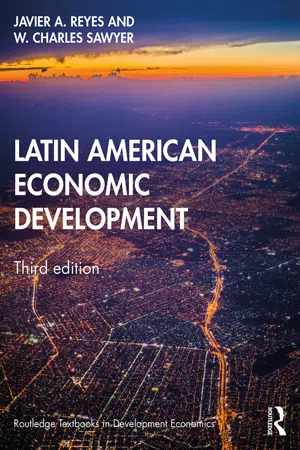Introduction
Since you are reading this book, it is safe to assume that you have an interest in Latin America. That’s understandable. Latin America is a very interesting region of the world for any number of reasons. In terms of world history, language, literature, music, and, more currently, sports, Latin America is a very influential part of the world. While this is common knowledge, the place of Latin America in the world economy usually is less well understood. If you were asked to write a paragraph about Latin America in the world economy, what would you write? For many, the answer would be “not much.” The first objective of this chapter is to provide you with some useful background information on the region. The focus of the chapter is to provide basic economic data for Latin America and then to put this information into a global context. In this way, we can learn something about the economies of the region and also learn how Latin America fits into the larger mosaic of the world economy. A second objective of the chapter is to introduce a number of recurring themes concerning the economies of Latin America. All of the world’s regions are distinctive in some ways. However, no region of the world, such as Europe, Asia, Africa, or Latin America, is completely homogeneous. Latin America is no different in this regard. There are several recurring themes that are common to most of the economies of Latin America. These major themes form a sort of roadmap for understanding both how the economies of Latin America are distinctive and why the economic performance of the region in the past century has been less than perhaps could have been possible. This introduction to these themes then allows us to consider some major economic policy debates that are common in the region. Economic growth in Latin America has spawned a healthy debate over various economic policy options for the region. Over the past century, several types of economic policies have been proposed and implemented. The relative merits of these policies have been vigorously debated for a long time. These policy debates are such an important part of the story of the economies of Latin America that the final part of the chapter provides a brief introduction to these different debates.
Latin America and the world
It’s a reasonably safe assumption that any person in the world who has completed primary school could find Latin America on a map. Latin America comprises 14 percent of the world’s land mass. In the Western Hemisphere, it accounts for 50 percent of the total area. However, the picture changes somewhat if one considers population. The population of Latin America is approximately 644 million, or 8.6 percent of the population of the world. However, Latin America makes up 64 percent of the population of the Western Hemisphere. Relative to much of the world, Latin America is not a particularly crowded place. There are exceptions, such as El Salvador, but in general the view of much of Latin America, outside the major cities, is more like the US or Australia than Europe or some parts of Asia. With nearly 10 percent of the population of the world, Latin America is obviously an important place. However, this percentage perhaps paints too limited a picture of the importance of the population of Latin America. Part of this importance can be traced to the movements of people over the centuries. Countless millions have immigrated to Latin America in search of a better life. This immigration has created one of the most fascinatingly diverse regions of the world. The culture of Latin America is diversity in action. The indigenous culture of the area is overlaid with immigration from Europe, Africa, Asia, and the Middle East. Immigrants from Latin America to North America, Europe, and most recently Asia have in both small and large ways changed the character of these regions. The importance of Latin America in the world extends beyond its borders, as millions of people living outside the region have, in some measure, a connection to it.
Latin America has also made more general contributions to the world at large. Nearly 500 million people in the world speak Spanish, making it the world’s second most used language after Mandarin. Another 200 million people speak Portuguese. This linguistic influence spreads beyond the borders of Latin America to the rest of the world. Spanish and Portuguese terms have crept into many of the world’s languages through books, poetry, music, and films. Spanish words and phrases are now part of the language of the world. In the modern world, images from Buenos Aires, Rio de Janeiro, or Mexico City are as familiar as those from London, Paris, or Sydney. A similar story exists with respect to history. The pre-Columbian civilizations of Mexico, Central America, and South America are well-known parts of the cultural heritage of the world. The literature of the region has been recognized by Nobel Prizes. Many forms of music, dance, or art are immediately recognizable outside the region as being “Latin American.” It would take too long to discuss Latin America and sports. It is difficult to imagine football (the real one), tennis, boxing, American baseball, or track and field without teams and individual athletes from Latin America. All of this is just a way of expressing the importance of Latin America to the world at large. However, this book has a more specific purpose. In order to get a complete view of the importance of Latin America to the world, the study of the economics of Latin America is critical. In the next section, we’ll begin our study of the economy of Latin America.
